Ask Ethan: Can the Universe still end in a Big Crunch?
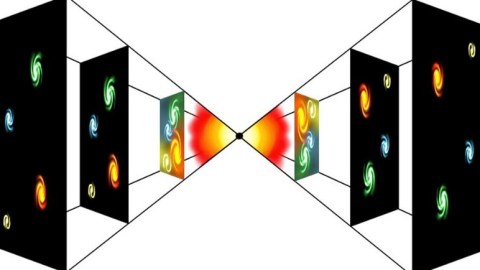
Dark energy may be real and the Universe may be accelerating, but does that mean a Big Freeze is inevitable?
“It’s everywhere, really. It’s between the galaxies. It is in this room. We believe that everywhere that you have space, empty space, that you cannot avoid having some of this dark energy.” –Adam Riess
One of the biggest advances of the 20th century has been to identify exactly how rich, expansive, and massive our Universe actually is. With approximately two trillion galaxies contained in a volume some 46 billion light years in radius centered on us, our Observable Universe allows us to reconstruct the entire tale of our cosmic history, stretching all the way back to the Big Bang and even, perhaps, slightly before. But what about the future? What about the fate of the Universe? Is that a certainty? That’s what Andy Moss wants to know, as he asks:
You [wrote] that the Universe is expanding at a decreasing rate. I thought a Nobel Prize was awarded for the “discovery” that the Universe was expanding at an increasing rate. Can you please clarify the leading theories? Is the “Big Crunch” still a possibility?
The best predictor of future behavior is past behavior, it’s true. But just as people can sometimes surprise us, the Universe might, too.
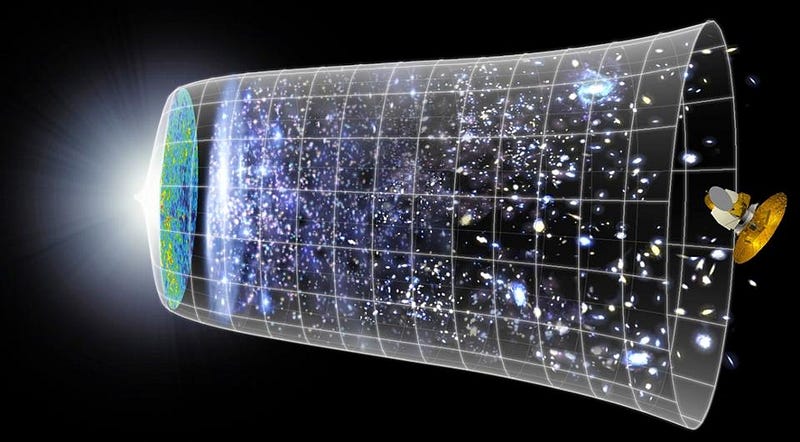
The expansion rate of the Universe, at any moment in time, is only dependent on two things: the total energy density present within spacetime and the amount of spatial curvature present. If we understand the laws of gravitation and how the different types of energy evolve over time, we can reconstruct what the expansion rate should have been at any moment in the past. We can also look out at a variety of distant objects at various distances, and measure how that light has been stretched due to the expansion of space. Every galaxy, supernova, molecular gas cloud, etc. — everything that absorbs or emits light — will tell the cosmic history of how the expansion of space has stretched it from the moment it was emitted until we observe it.
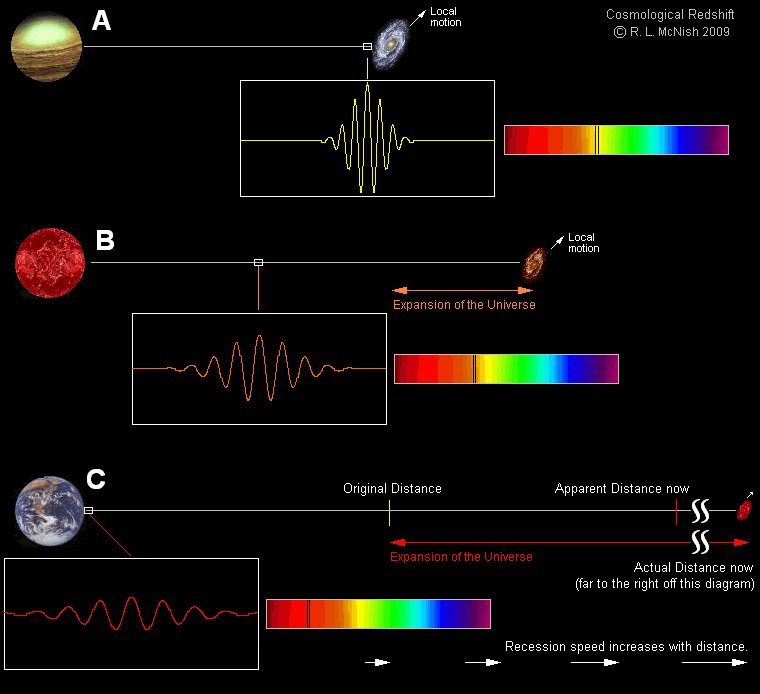
We’ve been able to conclude, from a variety of independent lines of observation, exactly what the Universe is made out of. The three big, independent lines of observation are:
- The temperature fluctuations present in the cosmic microwave background, which encode information about the Universe’s curvature, normal matter, dark matter, neutrino, and total density contents.
- The correlations between galaxies on the largest scales — known as baryon acoustic oscillations — which give very strict measurements on the total matter density, the normal matter to dark matter ratio, and the expansion rate throughout time.
- And the most distant, luminous standard candles in the Universe, type Ia supernova, which tell us about the expansion rate and dark energy as it evolved over time.
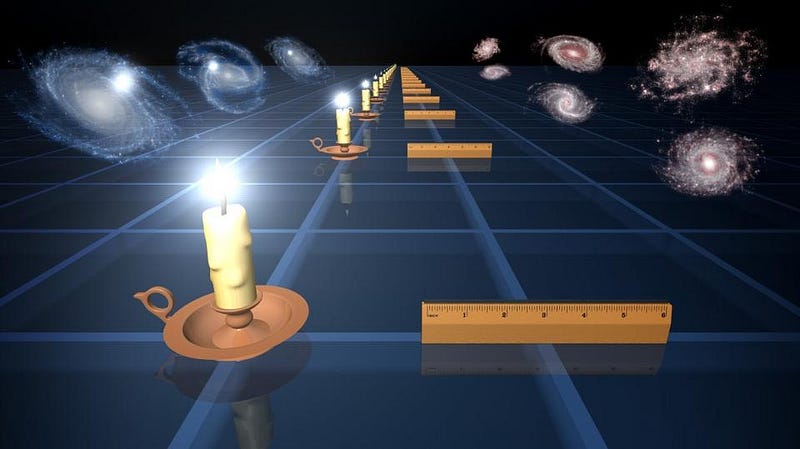
These lines of evidence, combined, all point to one consistent picture of the Universe. They tell us what’s in the Universe today, and give us a cosmology where:
- 4.9% of the Universe’s energy is in normal matter (like protons, neutrons and electrons),
- 0.1% of the Universe’s energy is in the form of massive neutrinos (which act like matter at late times and radiation at early times),
- 0.01% of the Universe’s energy is in the form of radiation (like photons),
- 27% of the Universe’s energy is in the form of dark matter, and
- 68% is in the form of energy inherent to space itself: dark energy.
They give us a flat Universe (with 0% curvature), a Universe with no topological defects (magnetic monopoles, cosmic strings, domain walls, or cosmic textures), and a Universe whose past expansion history is known.
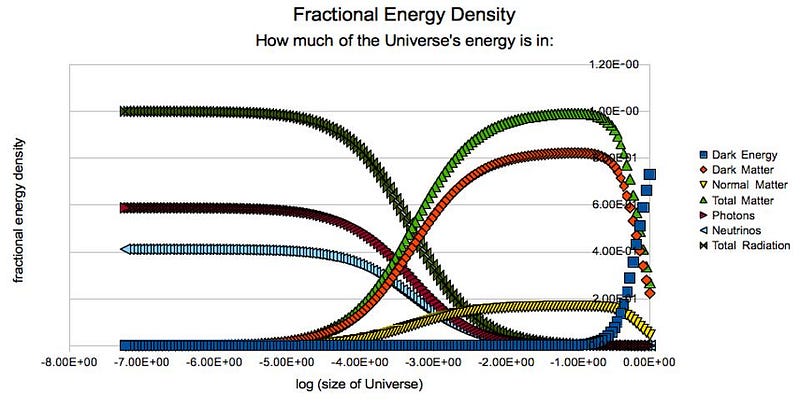
The equations governing General Relativity are very deterministic in this sense: if we know what the Universe is made of today and the laws of gravity, we know exactly how important each component was at every juncture in the past. Early on, radiation and neutrinos dominated. For billions of years, dark matter and normal matter were the most important pieces. And for the past few billion years — and this will get more severe as time goes on — dark energy is the dominant factor in the Universe’s expansion. It’s causing the Universe to accelerate, and this is where the confusion (for most people) begins.
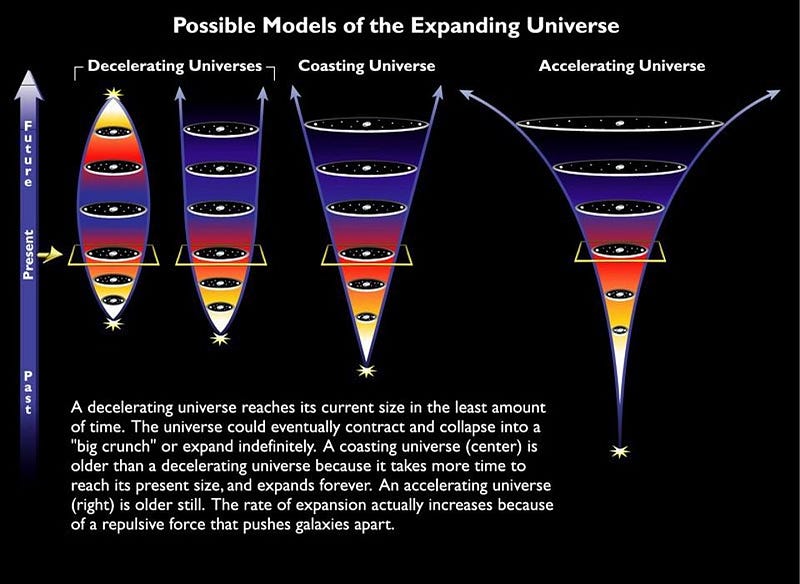
There are two things we can measure when it comes to the Universe’s expansion: the expansion rate and the speed at which an individual galaxy appears to recede from our perspective. These are related, but they are not the same. The expansion rate, on one hand, talks about how the fabric of space itself stretches over time. It’s always quantified as a speed-per-unit-distance, which is typically given in kilometers-per-second (the speed) per Megaparsec (the distance), where a Megaparsec is about 3.26 million light years.
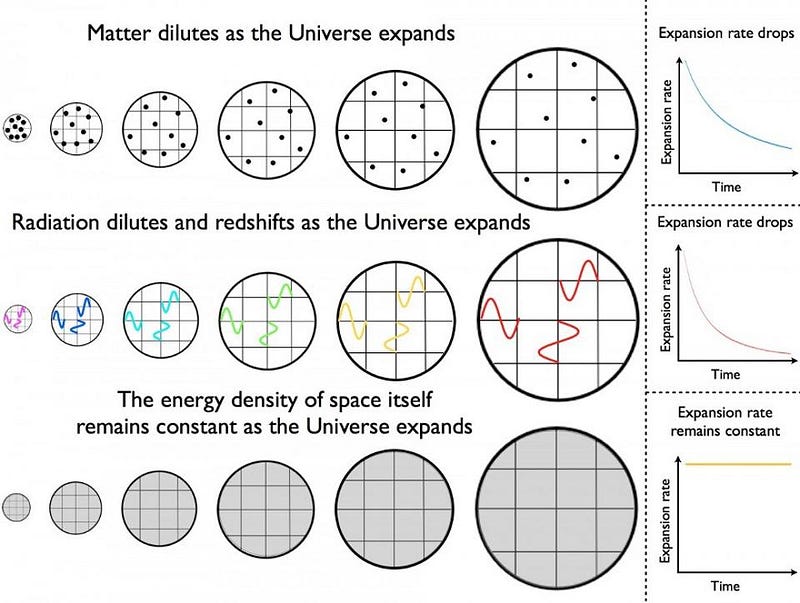
If there were no dark energy, the expansion rate would drop over time, approaching zero, since the matter-and-radiation density would drop to zero as the volume expands. But with dark energy, that expansion rate approaches whatever energy density dark energy has. If dark energy, for example, is a cosmological constant, then the expansion rate asymptotes to a constant value. But if that’s what the expansion rate does, then individual galaxies receding from us will see their speeds accelerate.
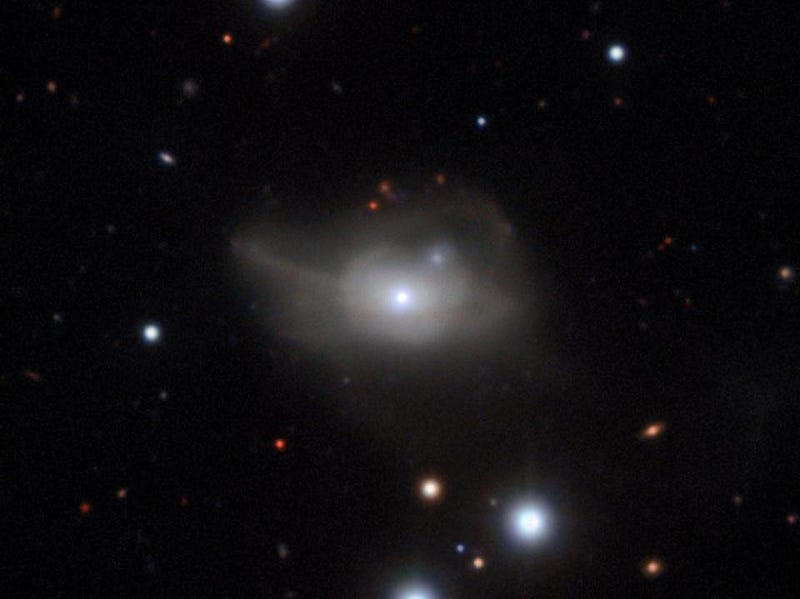
Imagine the expansion rate is some value: 50 km/s/Mpc. If a galaxy is 20 Mpc away, then it appears to recede from us at 1,000 km/s. But give it time; as the fabric of space expands, this galaxy will eventually be farther from us. By time it’s twice as distant, 40 Mpc away from us, it will appear to recede at 2,000 km/s. Over even more time, it will be ten times as far as it began: 200 Mpc, where it now recedes at 10,000 km/s. By time it gets to a distance of 6,000 Mpc from us, it will appear to recede at 300,000 km/s, which is faster than the speed of light. But this goes on and on; the more time passes, the faster the galaxy appears to move away from us. This is what’s “accelerating” about the Universe: the expansion rate goes down, but the speed an individual galaxy moves away from us just rises and rises over time.
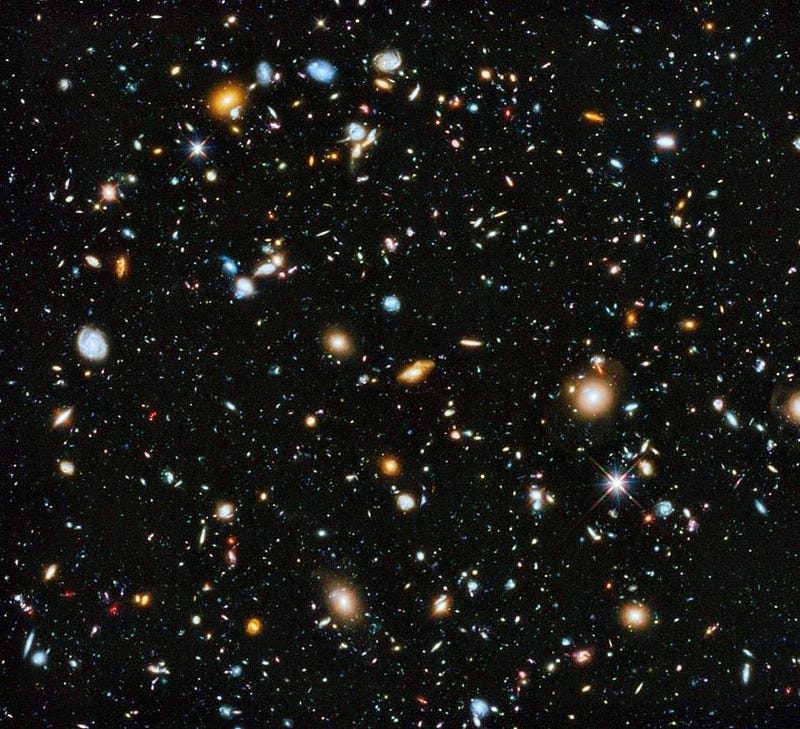
All of this is consistent with our best measurements: that dark energy represents a constant energy density inherent to space itself. As space stretches, the dark energy density remains constant, and the Universe will end in this “Big Freeze” fate, where everything that isn’t gravitationally bound together (like our local group, galaxy, solar system, etc.) winds up being pushed apart from one another. If dark energy is truly a cosmological constant, then the expansion will continue indefinitely, giving rise to a cold, empty Universe.
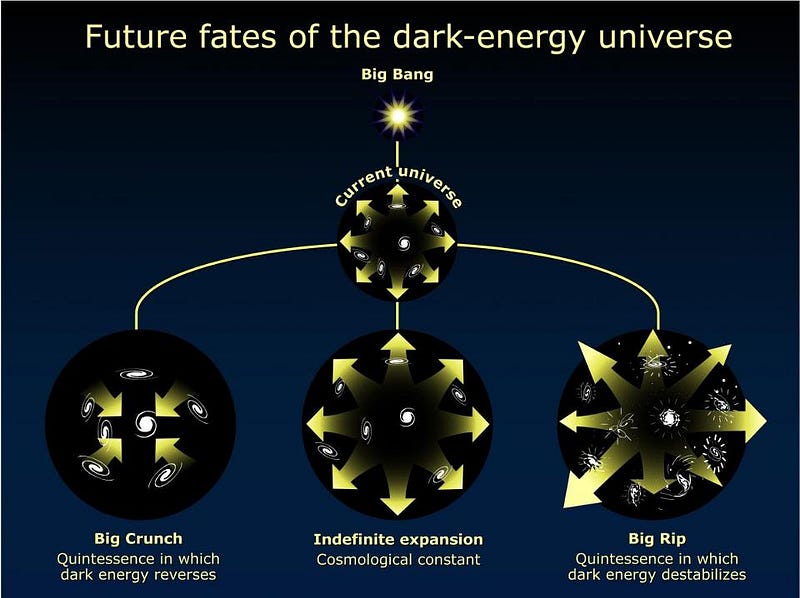
But if dark energy is dynamical — something theoretically possible but observationally without support — it could yet end in a Big Crunch or a Big Rip. In a Big Crunch, dark energy would weaken and reverse sign, causing the Universe to reach a maximum size, turn around, and contract. It could even give rise to a cyclical Universe, where the “crunch” gives rise to another Big Bang. If dark energy continues to strengthen, however, the opposite fate occurs, where bound structures eventually get torn apart by the increasing expansion rate. The evidence we have today, however, overwhelmingly supports a “Big Freeze,” the condition of expansion continuing at a constant rate forever.
The major science goals of upcoming observatories like the ESA’s Euclid, NASA’s WFIRST, and the ground-based LSST include measuring whether dark energy is truly a cosmological constant or not. Although the leading theoretical idea is, in fact, in favor of constant dark energy, it’s important to entertain all the possibilities not ruled out by our measurements and observations. As far fetched as it may seem, a Big Crunch still isn’t ruled out. With more and better data, we may yet find a compelling hint that reality is even stranger than most of us have imagined!
Send in your Ask Ethan questions to startswithabang at gmail dot com!
Ethan Siegel is the author of Beyond the Galaxy and Treknology. You can pre-order his third book, currently in development: the Encyclopaedia Cosmologica.




